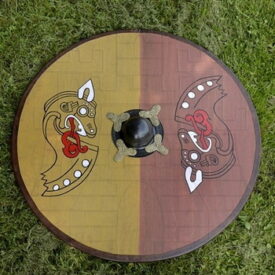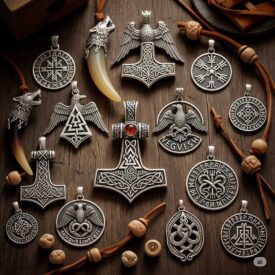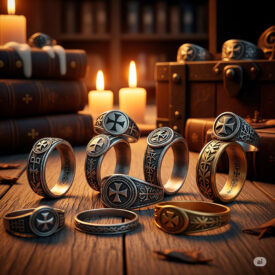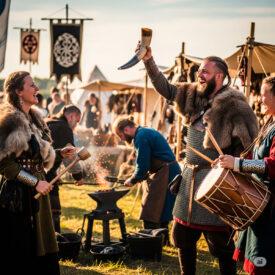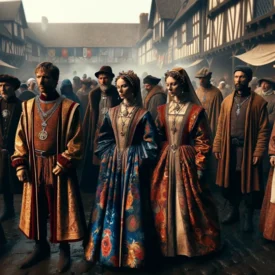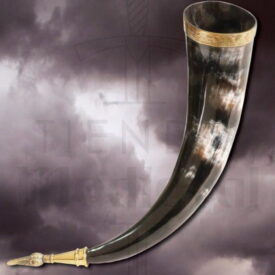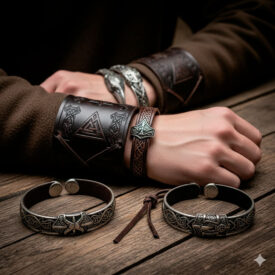The Vikings, a Scandinavian people who thrived between the 8th and 11th centuries, left a cultural legacy as vast as their maritime explorations. From their impressive sagas and intricate mythology to their bold expeditions and distinctive craftsmanship, every facet of their civilization reveals a complex and fascinating society. Among the most captivating aspects of their rich material culture, jewelry holds a special place, and within it, the torque stands out as a piece with deep roots in history, art, and symbolism. These stunning pieces were not mere ornaments to beautify the body; they were powerful emblems representing status, power, wealth, alliances, and profound spiritual convictions. Let us dive into the captivating world of these necklaces and bracelets, unveiling their deep meaning, the immense craftsmanship behind their creation, and their enduring legacy in the contemporary world.
What is a Viking Torque?
A torque (from the Latin torques, meaning “twisted” or “coiled”) was a type of rigid ornament, typically in the form of a necklace or bracelet. Its most distinctive feature was its open structure at one end and its often twisted or spiral braided design, which gave it a robust yet elegant appearance. For the Vikings, the torque was, along with the bracelet and brooches, one of the most representative and significant pieces of jewelry. These items could have a smooth and polished surface or be richly decorated with complex engravings, intricate patterns, and even, in some exceptional cases, inlays of precious materials.
The torque is a rigid, round necklace, open at the front, with both ends ornamented and sculpted with spheres, cubes, or, more commonly, zoomorphic shapes (animal heads such as dragons, wolves, or snakes) and, at times, stylized human figures. It was majestically placed around the neck, like a collar, and its name directly referred to the twisted shape of the metal. Bracelets, torques, and pendants were considered items of immense value for the Vikings, not only for their material composition but also for what they represented.
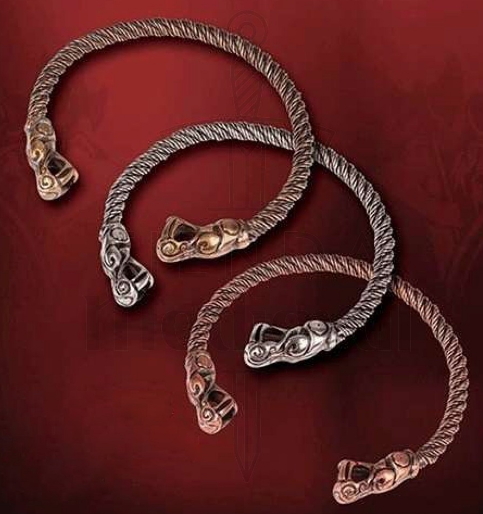
Although torques are strongly associated with Celtic culture, where they were considered the most valuable jewelry and could be made of bronze or gold depending on the rank of the wearer, they were also prominent and highly valued in the Viking world. In fact, ancient chronicles, such as those by Roman historians, describe Celtic warriors, like the fearsome gaesatae, fighting naked but adorned with torques and gold bracelets—a sight that inspired fear and respect in their enemies. This tradition of wearing torques as a symbol of power and status spread across various European cultures, and the Vikings adopted and adapted this practice, imprinting it with their own distinctive style and symbolism.
Symbolism and Deep Meaning: More Than an Ornament
Viking jewelry, and torques in particular, went far beyond the purely aesthetic; they were imbued with immense cultural, social, and symbolic value. Owning a torque was a clear and unequivocal sign of power, honor, wealth, and a high social position within the Viking hierarchy. They were prestigious gifts among chiefs and warriors, sealing alliances and loyalties. For some, these pieces even offered protection against evil, strength in battle, and a tangible connection with the gods and cosmic forces.
Viking goldsmithing not only identified status in society but was also a tangible record of successes in battle and bold overseas expeditions. Each piece could tell a story of distant travels, heroic victories, or important pacts. Both Viking women and men wore torques, bracelets, brooches, earrings, necklaces, and other pieces of jewelry, each with its own meaning and purpose.
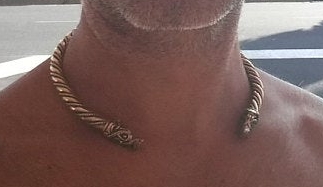
The designs present on torques also had their own language and narrative. For example, braided chain necklaces, with their multiple intertwined strands, could symbolize the interconnectedness of all things in the cosmos, the unity of the community, or the unbreakable bonds of fate. Twisted or coiled rings often represented the incessant flow of time, the cycle of life and death, and the inescapable nature of fate (wyrd). The intricate interlaced patterns, so characteristic of Viking art (such as the Borre, Jellinge, Ringerike, and Urnes styles), reflected the complexity of both human and divine relationships, the interconnection between the mortal world and the realm of the gods, and the cyclical nature of existence.
In addition to abstract patterns, many torques incorporated zoomorphic motifs that were deeply significant in Norse mythology. Dragon or serpent heads, like Jörmungandr (the Midgard serpent), could symbolize primordial chaos, protection, or indomitable strength. Wolf heads, such as Geri and Freki (Odin’s wolves) or Fenrir, could represent loyalty, ferocity in battle, or the destructive forces of nature. Ravens, like Huginn and Muninn (Odin’s thought and memory), symbolized wisdom, knowledge, and the connection with the divine realm. Thus, each torque could tell a story, invoke a belief, or serve as an amulet, becoming a tangible extension of its owner’s identity, beliefs, and legacy.
The Mastery of Viking Goldsmithing
The Viking Age was a period of remarkable advances in metallurgy and goldsmithing, which allowed their craftsmen to create metal pieces with formidable utility and exquisite beauty. The skill of a blacksmith or goldsmith was highly valued in Viking society, and these artisans enjoyed a respected status, often comparable to that of a warrior or leader, in their communities. Their ability to transform metals into objects of art and function was seen as almost magical, and their workshops were centers of innovation and creation.
For the manufacture of torques and other jewelry, the Vikings mainly used metals such as silver, bronze, gold, and, to a lesser extent but no less important, iron. The choice of metal often depended on availability, the status of the wearer, and the function of the piece. In particular, silver was a very common and valued material for Viking jewelry, often obtained through raids and trade, and was worked using weaving, braiding, and filigree techniques. The complexity of these braids was not only aesthetically attractive, creating a visually rich effect, but also indicated the value, quality, and skill of the craftsman who forged the piece.
There were also torque-shaped bracelets, likewise made of intertwined metal cords, usually gold, bronze, or copper, and in very few cases, silver. These bracelets replicated the aesthetics and symbolism of the necklaces, being equally appreciated as symbols of status and wealth.
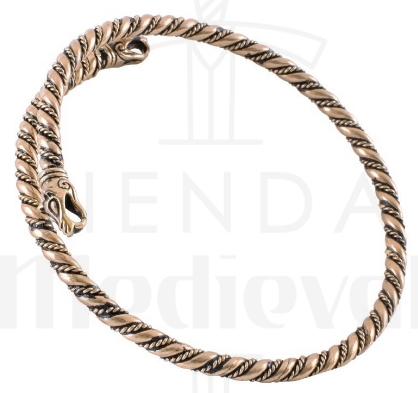
In addition to forging, casting, and alloying techniques, the Vikings developed and perfected a variety of decorative techniques. One of these, though not exclusive, was “chipping” or the use of punches to create textures and facets on the metal surface. This technique consisted of working the surface of the metal with a chisel or punch to create small facets or marks that produced a shiny and reflective effect, since gemstones were not a commonly used decorative element in their jewelry, unlike other cultures. This attention to detail in design, skill in handling available materials, and the sophistication of their artisanal techniques are eloquent testimony to their goldsmithing mastery and deep aesthetic sense.
Viking artisans also mastered the technique of granulation and filigree, where small granules or metal threads were soldered to the surface of the jewel to create intricate patterns and rich textures. The use of molds for casting allowed the production of more complex and uniform pieces, while embossing and chiseling added fine details and visual narratives to the metal surface. The combination of these techniques, along with a deep knowledge of metals and their properties, allowed the Vikings to create jewelry that was not only functional and durable but also works of art of astonishing beauty and complexity.
Torques in Viking Society and Their Legacy Today
Torques were used by both men and women in Viking society, although their design and size could vary according to gender and purpose. Their use was not limited to the mere display of wealth or status; they could also function as a form of currency or means of payment in commercial exchanges and the economy of the time. In a world where minted currency was not so common or universal, the intrinsic value of precious metals and the craftsmanship of torques made them a portable and recognized form of wealth. A finely crafted torque not only enhanced the social position of its wearer, but often became a family heirloom, passed down from generation to generation, preserving the lineage, honor, and legacy of a clan or family.
Bracelets and rings were for the Vikings what medals are today for the best warriors. They were awarded by chiefs and kings to their most loyal and brave warriors as a reward for service, bravery in battle, or participation in successful expeditions. Each bracelet or ring could represent an oath, a victory, or an achievement, becoming an integral part of the warrior’s identity. The torque, in particular, was a very common handcrafted piece among Nordic and Celtic peoples and denoted rank, authority, and connection with the community.
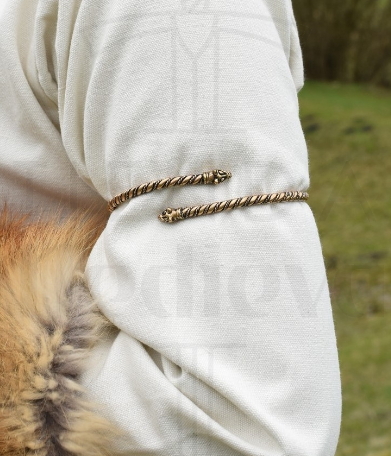
Today, interest in Viking torques and Nordic jewelry remains alive and constantly growing. These pieces are coveted by a wide range of people: from history enthusiasts and archaeologists seeking to better understand the past, to historical reenactors who desire authenticity in their outfits, and those who simply seek to connect with the symbolism of strength, protection, connection, and heritage inherent to Nordic culture. The demand for high-quality replicas has led contemporary artisans and specialized companies to recreate these historical designs, paying meticulous attention to materials, traditional manufacturing techniques, and the authentic details that characterized the original pieces. These timeless items not only complement medieval or historical reenactment outfits but also integrate perfectly with contemporary clothing, adding a distinctive element, a touch of mystery, and a powerful connection to a legendary past.
The popularity of torques has also been boosted by their appearance in television series, movies, and video games that explore Viking mythology and history, such as “Vikings” or “The Last Kingdom.” These representations have introduced a new generation to the fascinating world of Nordic jewelry, sparking renewed interest in the craftsmanship and symbolism of these pieces. Art collectors, alternative fashion enthusiasts, and people seeking jewelry with deeper meaning find in Viking torques a unique expression of their individuality and appreciation for history and mythology.
Care and Preservation of Your Viking Torque
For those who appreciate the beauty and meaning of Viking torques today, whether authentic replicas or inspired pieces, it is essential to ensure their proper preservation. Proper maintenance is key to preserving the beauty, shine, and integrity of any piece of jewelry, especially those that evoke such a rich historical legacy. Diligent care will ensure that your torque remains a valuable and attractive piece for many years.
If your torque is made of silver, it is advisable to polish it regularly with a soft cloth specifically for silver jewelry to maintain its shine and avoid oxidation, which can cause undesirable darkening. Bronze pieces benefit from occasional cleaning with warm water and mild soap, using a soft-bristled brush to remove dirt accumulated in the details. After cleaning, make sure to dry the piece completely to avoid water stains or corrosion.
It is crucial to avoid exposing any type of jewelry to harsh chemicals, such as household cleaners, perfumes, hair sprays, or chlorine, as they can damage the metal, alter its color, or corrode its surface. Likewise, it is advisable to remove the torque before swimming in chlorinated pools or the sea, as salt water can also be harmful to many metals. To prevent any deterioration, store each piece separately in soft fabric bags, such as velvet or cotton, or in padded boxes that prevent contact with other jewelry and possible scratches. Make sure the storage place is dry and cool to avoid humidity, which is a main factor in corrosion, especially in metals like iron or bronze.
If you own a torque with intricate details or inlays, consider taking it to a professional jeweler for periodic cleaning and maintenance. They can provide deeper and more specialized cleaning, as well as check for any signs of wear that may require repair. Preventive and regular care is the best way to ensure that your Viking torque retains its splendor and value over time, allowing you to enjoy this tangible connection with rich Nordic history.
Viking torques are much more than simple objects; they are time capsules that speak to us of a civilization with a deep respect for craftsmanship, symbolism, and personal expression. From their function as a mark of status, wealth, and alliances to their role in rituals and beliefs, these impressive pieces continue to resonate in our current culture, serving as a powerful reminder of the ingenuity, adventurous spirit, and rich heritage of the Nordic peoples. If you are drawn to the strength and beauty of these legendary jewels, we invite you to explore our collection.
At Medieval Shop, you will find a wide selection of torques inspired by authentic Viking goldsmithing, as well as a variety of Viking pendants and Viking bracelets that capture the essence of this fascinating era. Discover the perfect piece to carry a piece of history with you and celebrate the legacy of the Vikings.
